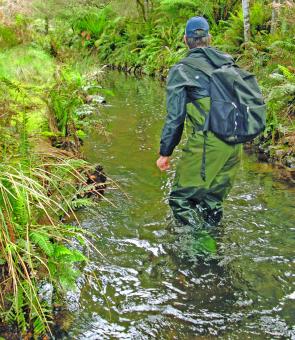You’ve just got to love summer in Tasmania.
One minute you’re hauled up in the lounge-room fighting for the best position near the open fire, the next you’re applying layers of aloe Vera to your delicate Scottish skin from over-exposure to the harmful UV rays that Tasmania experiences. I could blame the intermittent weather, but perhaps a lapse in brain function also played some part.
Now that Christmas and its associated, often hectic schedules are over, we can concentrate on what this period is really about – family, free time and fishing! I could think of no better time of year than this to grab a tent and the family and set-up near a river - or any waterway for that matter. I’m certainly looking forward to getting my little man out there amongst the action.
The trout season on the rivers so far has been one of the best in years, with regular flushing helping to enhance the health of many ecosystems. Trout tucker has been varied and populations have been large, like the mayfly.
Fly anglers in particular have long been fascinated with the association between trout and mayfly, and with good reason. To watch these little critters dance on the water and to observe the systematic patterns of some trout can be a daylong reverie.
Both red and black spinner hatches on the Macquarie and South Esk rivers have been sensational this season, and trout hoovering them have been on the higher end of athletic – both in physical shape and vigour! There have certainly been some obese specimens out of these waters this season, but fish of around 1kg have fought just as hard as the larger kind.
Small heads and thick shoulders are an indication of a healthy fish and I personally don’t eat trout (not that keen on the taste!), but I’m sure the thousands of anglers who do would appreciate the current robustness of our rivers and the trout within.
The two rivers above, along with the North Esk and other midland rivers will see a decline in mayfly numbers throughout January, with food items such as beetles, grasshoppers and ants becoming more common. Long-range forecasts seem to indicate a wetter than average summer (like the last two) but hopefully the grasshopper season will be more of an event, as last year was a bit of an anticlimax.
Still, trout in ‘hopper-prone locations are sometimes still acquainted with a familiar ‘plop’ on the water, allowing for some sloppier casts at this time of year. It reminds me of an adage one of my cobbers always conveys: “If we keep throwing flies at them, maybe they’ll think there’s a hatch on”.
Smaller waters like the St Patricks catchment and the upper reaches of the North and South Esk have been fishing really well. The waters in this vicinity are so clear and such a pleasure to fish when native timbers and clear-running water that’s perfect for polaroiding surround you. Some fish tend to seek refuge out of the sun in the peak of a warm day, so be sure to look in the shadows and prospect likely drop-offs and bubble lines.
My absolute go-to fly at this time of year is without a doubt a Royal Wulff. I will strap on other flies if things get tough but a Royal in a size 14 attracts plenty of attention! Another recommendation on the rivers if you plan to fish until dark is to take a headlamp – rising fish sometimes go berserk as the sun lowers and it’s a shame to leave at the thought of being unable to navigate your way back to the car. A headlamp will also assist in tying flies on for that last riser!
Even if you can’t quite see where you are casting, give it a go anyway and even strip it across the surface. This technique sometimes results in savage takes. The smaller waters fish well from the start to the end of season and will only provide stacks of satisfaction as the season progresses.
I’ve not fished Four Springs for some time but I hear that red-letter days are more the exception than the norm, with many struggling to find active numbers of fish on the surface. Weed growth has also made it difficult for the lure angler in around 40% of the lake. It always shows up in summer but it harbours plenty of tucker so the angler needn’t worry about the health of this system.
Damselflies are up and about as are the larger dragonflies. You could do worse than tying on a mudeye pattern as dusk approaches. Keep an eye on Huntsman Lake and Brushy Lagoon for this type of activity also.
January is a fantastic time of year to fish the rivers and although there are plenty of people out fishing due to leave and school holidays, there are so many options to seek some solace away from others. Windy days can sometimes be a pain and if this is the case on your chosen day, simply head to smaller waters that have plenty of bank-side vegetation and get stuck into them.
Keep a keen eye out for Joe Blakes!
Reads: 1386
Small creeks are the ticket when the wind gets too strong.

Four Springs has been hit and miss, but with big trout like this about, you ca put up with a few hard days.

Small fish in small waters are a delight.

Small creeks in the midst of rainforest are the most beautiful of trout waters.




